
Collomia grandiflora is a western North American annual plant in the phlox family (Polemoniaceae), known by the common names grand collomia, large-flowered mountain trumpet, and large-flowered collomia. It is cultivated as an ornamental.
Euphorbia eriantha is a species of spurge known by the common name beetle spurge. It is native to the deserts of northern Mexico and the southwestern United States from California to Texas. This is an annual herb reaching anywhere from 15 to 50 centimeters in height. The leaves are long, narrow, and pointed, sometimes with sparse hairs, and 2 to 7 centimeters long. The foliage may be dark in color, from greenish to purplish or reddish. The inflorescence appears at the tip of the branch and contains staminate or pistillate flowers which are just a few millimeters wide. The fruit is an oblong, hairy capsule half a centimeter long, with gray and black mottling. It contains bumpy white or gray seeds.
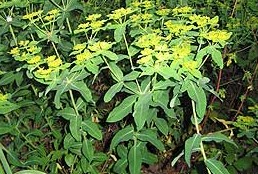
Euphorbia oblongata is a species of spurge known by the common names Balkan spurge, eggleaf spurge and oblong spurge. It is native to Eurasia but can be found elsewhere as a weedy introduced species. This is a hairy perennial herb growing to maximum heights of just over half a metre. It has oval-shaped or narrow leaves with finely toothed edges which are 4 to 6 centimetres long. The foliage is green to yellow-green. The inflorescences hold tiny glandular flowers. The fruit is a spherical capsule about half a centimetre long which contains smooth brown seeds.
Euphorbia lurida is a species of spurge known by the common name woodland spurge. It is native to the southwestern United States from California to Utah, where it can be found in a number of habitats. This is a common perennial herb usually not exceeding half a meter in height. It has small oval green leaves all along its erect stems. The inflorescences at the tips of the stems have tiny glandular flowers with ridged or toothed tips. The fruit is a rounded capsule a few millimeters wide containing tiny gray seeds.
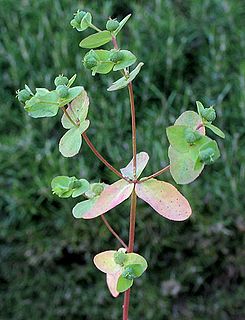
Euphorbia spathulata is a species of spurge known by the common names warty spurge and roughpod spurge.

Leontodon taraxacoides is a species of hawkbit known by the common name lesser hawkbit, rough hawkbit, or hairy hawkbit. It is native to Europe and North Africa but it can be found in many other places across the globe as an introduced species and often a noxious weed. This is a dandelion-like herb growing patches of many erect, leafless stems from a basal rosette of leaves. The leaves are 2 to 15 centimeters long, 0.5 to 2.5 centimeters wide, entire or lobed, and green in color. Atop the stems are solitary flower heads which are ligulate, containing layered rings of ray florets with no disc florets. The florets are yellow with toothed tips. The fruit is a cylindrical achene with a pappus of scales. Fruits near the center of the flower head are rough, while those growing along the edges of the head are smooth.
Arctostaphylos malloryi is a species of manzanita known by the common name Mallory's manzanita. It is endemic to California.

Camissonia pubens is a species of evening primrose known by the common name hairy suncup. It is native to the desert and steppe of western Nevada and eastern California. It is an annual herb covered in glandular hairs generally made up of one or more erect, slender stems up to a third of a meter tall. The leaves are up to about 4 centimeters long and are lance-shaped with wavy, toothed edges. The nodding inflorescence produces flowers with yellow petals each a few millimeters long and sometimes dotted with red near the bases. The fruit is a straight or coiling capsule up to 5 centimeters long.
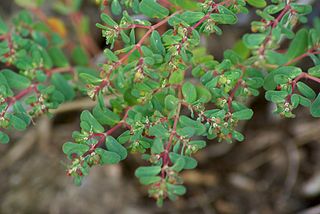
Euphorbia serpyllifolia is a species of euphorb known by the common names thymeleaf sandmat or thyme-leafed spurge. It is native to a large part of North America from Canada to Mexico, where it is a common member of the flora in many types of habitat. This is an annual herb growing as a prostrate mat or taking a somewhat erect form. The oblong leaves are up to about 1.5 centimeters long, sometimes hairy and finely toothed along the edges. The tiny inflorescence is a cyathium about a millimeter wide. It bears scalloped white petal-like appendages arranged around the actual flowers. At the center are several male flowers and one female flower, which develops into a lobed, oval fruit up to 2 millimeters wide. This plant had a number of traditional medicinal uses for many Native American groups.

Lessingia glandulifera is a species of flowering plant in the daisy family known by the common name valley lessingia. It is native to California and Baja California, where it grows in several types of habitat, from forest and desert to the coastline. This is an annual herb varying in maximum size from under 10 to nearly 80 centimeters in height, growing erect to decumbent. It is hairless to very hairy and glandular. The leaves are widely lance-shaped and toothed, the lowest approaching 11 centimeters in maximum length. The upper leaves are often studded with knobby glands. The flower heads appear singly at the tips of the stem branches. Each head is lined with phyllaries covered in large glands and sometimes many hairs. The head is discoid, containing no ray florets but many funnel-shaped disc florets with lobes that resemble ray florets. The disc florets are yellow with brown throats. The fruit is an achene with a whitish pappus.

Nothochelone is a monotypic genus of flowering plants in the plantain family containing the single species Nothochelone nemorosa, which is known by the common name woodland beardtongue. Originally described as Penstemon nemorosus, the plant is very similar in appearance to the penstemons, but was separated and placed into its own genus on the basis of slight morphological differences, such as winged seeds.

Pedicularis centranthera is a species of flowering plant in the family Orobanchaceae known by the common names dwarf lousewort and Great Basin lousewort. It is native to the western United States from eastern Oregon and California to Colorado and New Mexico, where it grows in sagebrush and other basin and plateau habitat. It is a perennial herb producing several short stems a few centimeters tall from a basal caudex. The leaves are up to 20 centimeters long, lance-shaped and divided into many overlapping toothed, wrinkled, or fringed lobes. The inflorescence is a short raceme bearing many long, protruding, club-shaped flowers. Each flower may exceed 4 centimeters in length and is white or pale purple with dark purple tips on the wide ends of its upper and lower lips. The sepals of the flowers are shorter and hairy. The fruit is a capsule around centimeter long containing seeds with netlike surfaces.
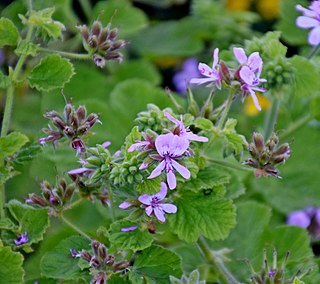
Pelargonium vitifolium is a species of geranium known by the common name grapeleaf geranium. It is native to South Africa, and it is a commonly grown ornamental plant. This is a mostly erect, branching shrub approaching one meter in maximum height. The stems are soft and coated in soft hairs when young and become more woody with age. The glandular, stiffly-hairy aromatic leaves are about 6 centimeters long and 8 wide, divided into 5 or 7 toothed, heart-shaped lobes. The inflorescence is a dense umbel of several flowers with five petals each around a centimeter long. The flowers are pink with purplish markings.
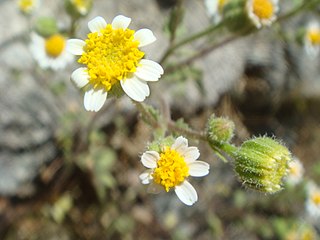
Perityle emoryi is a species of flowering plant in the aster family known by the common name Emory's rockdaisy. It is native to the Southwestern United States, northwest Mexico, and the Baja California Peninsula. It is a common wildflower of the deserts, and can also be found in California coastal regions.
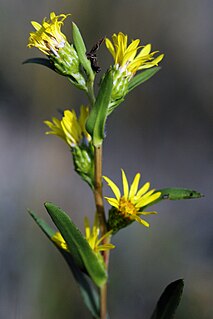
Pyrrocoma racemosa is a species of flowering plant in the aster family known by the common name clustered goldenweed. It is native to the western United States, where it grows in many types of habitat. It is quite variable in morphology, and there are several varieties which are sometimes hard to tell apart. In general, it is a perennial herb usually producing two or more mostly erect stems reaching maximum heights between 15 and 90 centimeters. The stems are reddish or brownish in color, leafy or not, and hairless to quite woolly. The longest leaves are located in tufts around the base of the stems. They are lance-shaped to oval, smooth-edged, wavy, or deeply spine-toothed, and may exceed 30 centimeters in length. Basal leaves are borne on woolly petioles. Leaves located higher on the stem lack petioles and may clasp the stem at their bases. The inflorescence is a cluster of several flower heads lined with phyllaries which may be over a centimeter long and are hairy to hairless in texture. Each head contains many yellow disc florets and a fringe of several yellow ray florets. The fruit is an achene which may be over a centimeter long including its pappus.
Scrophularia atrata is an uncommon species of flowering plant in the figwort family known by the common names black-flowered figwort and darkflowered figwort. It is endemic to California, where it is known only from a section of the Central Coast Ranges in San Luis Obispo and Santa Barbara Counties. It grows in the calcareous and diatomaceous soils of the coastal canyons at elevations not exceeding 500 meters. There have been 44 observed occurrences of this species, but perhaps 25 of these are historic and may no longer exist. This plant is a perennial herb producing an erect, four-sided stem up to a meter tall or slightly taller. It is somewhat hairy to densely woolly in texture. The leaves have toothed oval blades up to 10 centimeters long which are borne on long petioles. The inflorescence is a wide-open panicle with several hairy, glandular branches bearing flowers. The flower has an urn-shaped corolla with a rounded body and an open mouth at the top which is edged with hoodlike lobes. The corolla is deep, dark red to nearly black in color. The fruit is a capsule just under a centimeter long containing many seeds.
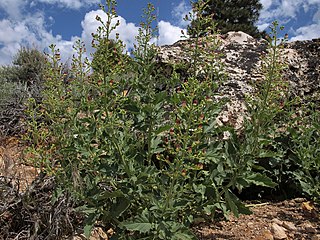
Scrophularia desertorum is a species of flowering plant in the figwort family known by the common name desert figwort. It is native to eastern California and Nevada, where it grows in dry areas in local mountain ranges, including the Sierra Nevada and the desert ranges adjacent. It is a perennial herb producing clusters of erect stems that often exceed one meter tall. The leaves have toothed, triangular or lance-shaped blades up to 13 centimeters long which are borne on petioles measuring up to 10 centimeters in length. The inflorescence is a wide-open panicle with several hairy, glandular branches bearing flowers. The flower has a spherical corolla opening at the top into a hoodlike, lobed mouth. The corolla is just under a centimeter long and is whitish at the base and deep red around the mouth and on the lobes. The staminode is generally visible in the mouth of the corolla. The fruit is a capsule just under a centimeter long containing many seeds.

Packera cana is a species of flowering plant in the aster family known by the common name woolly groundsel. It is native to western and central North America, where it can be found in a wide array of habitat types at all elevations from grassland to the alpine climates of mountain peaks.

Tragia ramosa is a species of flowering plant in the spurge family known by the common names branched noseburn and desert tragia.

Viola lobata is a species of violet known by the common name pine violet. It is native to western North America from southern Oregon through California and into northern Baja California, where it occurs in mountain ranges and foothills. It grows in woodlands and other habitat. This rhizomatous herb produces an erect stem a few centimeters tall or growing to nearly half a meter in maximum height. The leaves have variously shaped blades borne on long petioles. The blades are 5 to 15 centimeters wide and may be hairless, hairy, or waxy in texture. The leaf blades are often divided into narrow lobes or dissected into small segments. The shape of the leaf blade differentiates the two subspecies; ssp. lobata has dissected leaves and ssp. integrifolia has entire or toothed blades. A solitary flower is borne on a long, upright stem. It has five yellow petals, all five or just the lower three with purple or brown veining and the upper two stained with purple or brown on the outer surfaces.
















